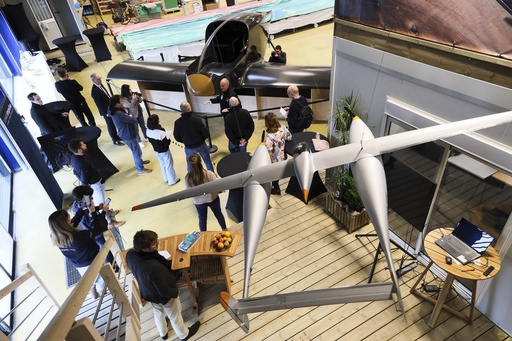
Based along the Atlantic coast of France, Piccard, along with his team, is developing Climate Impulse, a project initiated last February with the goal of achieving a nonstop, two-seater flight around the world over nine days, all powered by green hydrogen. This hydrogen is derived from water through a process called electrolysis, which employs renewable energy to split water molecules.
On Thursday, the Climate Impulse team, which has backing from major players like Airbus and the Syensqo incubator—developed from the Belgian pharmaceutical firm Solvay—shared their progress from the past year with journalists in Les Sables d’Olonne, a town famed for hosting the Vendee Globe sailing race.
When is the Climate Impulse set to take flight? Initial test flights are slated for next year, with the ambitious round-the-world attempt planned for 2028. The craft is being constructed from lightweight composite materials but relies on several innovative technologies that have yet to be tested in such a venture.
Piccard emphasizes that major aircraft manufacturers are hesitant to engage in the risk of developing a prototype like Climate Impulse, which could potentially fail. “It’s my job to be a pioneer,” he explained during an interview. “We have to show it’s possible; then it’s a big incentive for others to continue.”
However, even should this initiative see success, experts caution that widespread adoption of green hydrogen in aviation could take decades. The project has attracted tens of millions of euros in investments, and the team behind it continues to grow.
While the solar-powered aircraft was a remarkable technological achievement in 2015, it was not practical for commercial use, according to Climate Impulse engineer and co-pilot, Raphael Dinelli. The previous solar craft had limitations in range and required numerous stops during its journey around the world.
Climate Impulse aims to set a new standard by taking off without assistance and flying approximately 40,000 kilometers (about 25,000 miles) around the globe at the equator, all without mid-air refueling or any stops.
The design incorporates a system where controlled release of liquid hydrogen from highly insulated tanks under the wings generates energy directed into a fuel cell, ultimately powering the airplane. Piccard noted that the aircraft features a wingspan comparable to that of an Airbus 320, measuring around 34 meters (approximately 110 feet) and having a total weight of 5.5 tons with a cruising speed of 180 kilometers per hour (about 100 knots at 10,000 feet or 3,000 meters altitudes).
One of the project’s objectives is to harness energy from atmospheric turbulence, which could also benefit future airlines in terms of fuel efficiency, Piccard added. Since the aircraft will primarily run on hydrogen, its only emissions will be water vapor. Nonetheless, experts warn that the implications of such water vapor “contrails” on the environment are still largely uncharted for large-scale operations.
According to the International Energy Agency, air travel currently contributes around 2% of global carbon dioxide emissions. Hydrogen has been a component of flight for many years, traditionally used in gas form. Transitioning to liquid hydrogen presents its own challenges and will require significant scaling up. Presently, fossil fuels—which are less costly and more efficient—dominate hydrogen production.
Although many governments aim to boost the output of green hydrogen, the current capacity to generate sufficient clean electricity for comprehensive land-based activities falls short, making widespread aviation applications challenging.
What milestones has Climate Impulse achieved thus far, and what are the upcoming steps? In the past year, the team has made significant strides, including the construction of the cockpit shell, initializing work on the wing spar, and finalizing key interior elements such as ergonomic swivel seats, a bunk, and a compact exercise system designed to support co-pilots during their extended hours in a compact cabin with low oxygen levels.
Despite the progress, significant hurdles lie ahead. Testing is projected for this year to evaluate the fuel cells and propulsion systems to confirm that the combination of electric motor, propeller, and batteries will successfully support the initial electrics of the aircraft.
A pivotal challenge will be managing the flow of liquid hydrogen responsibly to maximize efficiency and range. Maintaining liquid hydrogen at nearly absolute zero—approximately -253 degrees Celsius (-423 Fahrenheit)—is critical, as any leakage poses substantial safety hazards due to its flammability.
As for the future of green hydrogen in aviation, its primary association has been with rocket propellant. Even though aviation contributes a relatively modest share of carbon emissions, it is increasing at a pace that outstrips other sectors as advancements in electric flight lag behind those for terrestrial electric vehicles.
Currently, weight is a significant concern; batteries used in electric vehicles are inherently heavy, and minimizing this weight is paramount for the feasibility of electric aircraft. “We have not had a ‘Tesla moment’ in aviation yet,” remarked Nikhil Sachdeva, an aviation consultant specializing in sustainable technologies. “Hydrogen has the potential to be that for aviation, which is why it’s worth doing this right.”
Utilizing super-cold liquid hydrogen poses extraordinary challenges. Current technology allows us to manage it for a few minutes, but the goal here is to ensure it can be done safely for extended periods.
Nonetheless, skepticism remains a common thread as Solar Impulse faced its fair share as well. Piccard’s team has shown that what many deemed impossible can indeed become a reality.

